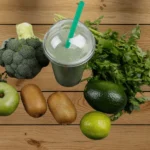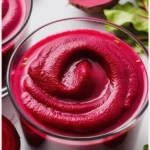Using the best juicer and choosing fruits and vegetables with high water content is key to getting the most juice. A fine mesh strainer helps you squeeze out every drop, ensuring no pulp, liquid, or goodness goes to waste.
Incorporating juicing into your diet increases your intake of vitamins, minerals, and the beneficial nutrients in fresh, homemade blends.
I love how making ultra-unprocessed, nutrient-packed juice at home beats the flavor of off-the-shelf options. With the proper regime, your yield will improve, and you’ll enjoy delicious, fresh, and wholesome drinks every day.
Ways to Get More Juice Out of Your Juicer
High-water-content produce and regular maintenance of your juicer boost juice yield. A masticating or triturating juicer extracts more juice efficiently.
1. Choose High-Water Content Fruits and Vegetables
Choosing fruits and vegetables with high water content is the key to extracting more juice from your juicer. Many fruits, like watermelon, which is 92% water, and cantaloupe at 90%, provide incredible juice-yielding potential due to their hydration-rich composition.
Similarly, veggies such as cucumbers, which contain 96% water, and tomatoes, which contain 94% water, can significantly boost your output.
For sweet and vibrant options, apples, pears, and pineapple bring a delightful balance of flavor and liquid gold thanks to their juicy nature and moisture content ranging from 84% to 87%.
Incorporating spinach or kale with honeydew or citrus fruits like oranges and grapefruits adds a refreshing, nutrient-rich blend.
Whether you’re pressing the sweetness of kiwis or the brilliant red juices of cherry tomatoes, focusing on high-yield produce ensures you maximize every drop.
Use a machine with the correct settings to handle these chunks and totals, blending smoothly for a vibrant and satisfying result.
2. Prep Your Ingredients Properly
Preparation plays a significant role in getting the most out of your ingredients when making juice. Even small changes can significantly boost the yield and improve the quality of your juice.
Always wash your fruits and vegetables thoroughly to remove dirt, debris, or pesticide residues—this step ensures a cleaner and healthier result.
For leafy greens, I’ve found that trimming tough stems and cutting out fibrous parts helps prevent clogging in the juicer and ensures a smoother juicing process. This method saves time and maximizes your juice’s nutritional value. Additionally, proper Storage Tips for your ingredients can further enhance their freshness and juice yield.
3. Use an Efficient Juicer
Masticating Juicers
Using the right equipment makes all the difference in getting the best juice from your produce. Masticating juicers, also called cold press or slow juicers, are highly effective because they work by squeezing and crushing fruits and veggies into pulp using a spiral rotating auger.
This gentle process avoids the heat generated by high-speed blades, which can degrade nutrients. His grinding action bursts the cell walls, yielding higher yields than centrifugal juicers.
Upgrading to a model from trusted brands like Omega, or Hurom can improve your results by 10-20%. A masticating mechanism ensures complete juicing, making it the perfect choice for fruit or veg.
Triturating Juicers
A twin-gear triturating juicer is one of the most efficient juice extractors. It uses two interlocking gears to powerfully crush produce at slow speeds. This cold press process thoroughly bursts open plant cell walls, delivering the highest juice yields possible.
You can expect 10–20 percent more juice from the same produce, especially compared to centrifugal juicers. The Super Angel Juicer, known as the gold standard, offers exceptional quality, albeit cheaply.
More affordable options, like those from Tribest, deliver excellent performance at lower costs. Investing in a top-notch masticating or triturating juicer guarantees that every last drop of valuable juice is extracted from your produce.
4. Squeeze Out Pulp with a Fine Mesh Strainer
After juicing, don’t toss out the leftover pulp—it still holds a surprising amount of juice! A fine mesh strainer or an elastic nut milk bag can help you extract even more.
Place the processed pulp into the strainer over a bowl, then gently press and massage it to release every drop of moisture. A nut milk bag is handy for catching tiny particles and creating a smoother textured juice.
For best results, wring and twisting the bag to maximize the juice you get. You could even gain an extra 10-25% juice this way, saving money while boosting the nutritional benefits.
A second round of pressing ensures no unused juice goes to waste, making every batch more efficient and rewarding.
5. Experiment with Leafy Greens
Juicing leafy greens like spinach, kale, and Swiss chard can be challenging, but these nutrient-packed vegetables are worth the effort.
To maximize yield, I’ve found that rolling the greens into tight bundles makes feeding them into the juicer much easier.
A trick I often use is to sandwich the greens between more complex fruits or vegetables like apples or carrots, which helps to extract more juice efficiently. This method saves time and ensures you don’t miss out on these greens’ goodness.
6. Add Citrus Ingredients
Adding citrus fruits like oranges, lemons, and limes can transform your juice with their bold, flavorful taste. These fruits enhance the flavor and break down tough fibers in vegetables, helping your juicer extract more juice efficiently.
I’ve found that incorporating them into blends yields better results, improving flavor and nutrition. Just a tiny squeeze of lemon or lime can brighten your juice, while whole citrus pieces can boost the output significantly.
Experiment with different combinations to see how much these ingredients elevate your juices.
7. Put Juice Pulp Back Through the Machine
Feed freshly extracted pulp back into your juicer for a second pressing to get more juice. This technique doubles the process using the mechanical crushing and squeezing action twice. Adding some fresh produce, like apples or cucumbers, helps prevent clogs and ensures a smooth process.
In my experience, blending old and new ingredients can boost juice yields by up to 10-20%, making it a simple and effective way to maximize your juicer’s potential.
8. Soak Produce Beforehand
Try soaking fruits and veggies in water for 2-6 hours before juicing to get more juice. This simple step lets the produce absorb liquid, swelling its internal cells with moisture.
When pressed, these hydrated, bursting cells release more juice, boosting yields by 10-25%. I often soak ingredients overnight for grab-and-go juicing in the morning, skipping the need to chop beforehand.
For the best results, remember to rinse soaked berries or grapes to remove excess sugars before using your juicer.
9. Clean and Maintain Your Juicer Regularly
Regular maintenance is important to ensure your slow juicer’s optimal performance and longevity. After each use, I always disassemble the parts and rinse them thoroughly under running water.
I mostly use a soft brush to gently remove pulp and residue from the juicing screen and other components.
For a deeper clean, I have found that soaking removable parts in warm, soapy water and gently scrubbing stubborn buildup works wonders. This simple routine ensures your juicer stays in top shape for maximum yield.
Conclusion
Implementing these practical tips and techniques can significantly enhance your juicing experience, ensuring you get the most out of your produce and your juicer.
From selecting high-water-content fruits and vegetables to investing in efficient juicing equipment and adopting clever practices like soaking produce or reusing pulp, every step maximizes juice yield while minimizing waste.
Juicing boosts your intake of essential nutrients and brings the joy of crafting fresh, delicious beverages tailored to your taste and health goals. You can enjoy the benefits of homemade, nutrient-rich juices every day with proper preparation, experimentation, and regular maintenance.
FAQ’s
Q: What is the 80/20 rule for juicing?
The 80/20 rule recommends using 80% vegetables and 20% fruit for an optimum mix with low sugar content and high nutrient count. Choose locally grown, organic produce to maximize health benefits.
Q: Is it OK to drink the pulp when juicing?
Yes, drinking pulp is perfectly fine. It’s rich in fiber and completely edible. It’s mashed produce with the water squeezed out, making it a nutritious addition to juice.
Q: What vegetables should not be juiced?
Some vegetables, like spinach and raw kale, contain oxalates and goitrogens, which can significantly affect thyroid function. Other sources of oxalates include bananas, mangoes, cauliflower, and cruciferous vegetables, so they cannot juice daily.







